Dielectric Properties of Glass Beads with Talc as a Reference Material for Calibration and Verification of Dielectric Methods and Devices for Measuring Soil Moisture
Abstract
1. Introduction
- Electromagnetic simulations of the seven-rod probe with different dimensions using the Ansys HFSS software (Version 19.2.0, ANSYS, Inc. Southpointe, Canonsburg, PA, USA).
- Measurements of the and values of talc, glass beads, and glass beads with 5% and 10% of talc under different moisture and salinity conditions (electrical conductivities of 0.5, 1.0, and 1.5 S·m−1) using the short seven-rod probe connected to a PNA-L N5230C VNA (Agilent Technologies, Santa Clara, CA, USA) in the operational frequency range of the probe.
- Comparison between and with well-known calibration equations at a several frequencies.
- Estimation of repeatability of the materials under test.
- Evaluation of the salinity index model.
2. Materials and Methods
2.1. Seven-Rod Probe
2.2. Materials Characteristics and Experiment
3. Results and Discussion
4. Conclusions
Author Contributions
Funding
Acknowledgments
Conflicts of Interest
References
- Robinson, D.A.; Jones, S.B.; Lebron, I.; Reinsch, S.; Domínguez, M.T.; Smith, A.R.; Jones, D.L.; Marshall, M.R.; Emmett, B.A. Experimental evidence for drought induced alternative stable states of soil moisture. Sci. Rep. 2016, 6, 1–6. [Google Scholar] [CrossRef] [PubMed]
- Nosalewicz, A.; Siecińska, J.; Kondracka, K.; Nosalewicz, M. The functioning of Festuca arundinacea and Lolium perenne under drought is improved to a different extend by the previous exposure to water deficit. Environ. Exp. Bot. 2018, 156, 271–278. [Google Scholar] [CrossRef]
- Skierucha, W.; Wilczek, A.; Szypłowska, A. Dielectric spectroscopy in agrophysics. Int. Agrophysics 2012, 26, 187–197. [Google Scholar] [CrossRef]
- Vaz, C.M.P.; Jones, S.; Meding, M.; Tuller, M. Evaluation of standard calibration functions for eight electromagnetic soil moisture sensors. Vadose Zone J. 2013, 12. [Google Scholar] [CrossRef]
- Topp, G.C.; Zegelin, S.; White, I. Impacts of the real and imaginary components of relative permittivity on time domain reflectometry measurements in soils. Soil Sci. Soc. Am. J. 2000, 64, 1244–1252. [Google Scholar] [CrossRef]
- Malicki, M.A.; Walczak, R.T. Evaluating soil salinity status from bulk electrical conductivity and permittivity. Eur. J. Soil Sci. 1999, 50, 505–514. [Google Scholar] [CrossRef]
- Matula, S.; Bát’ková, K.; Legese, W.L. Laboratory performance of five selected soil moisture sensors applying factory and own calibration equations for two soil media of different bulk density and salinity levels. Sensors (Switz.) 2016, 16, 1912. [Google Scholar] [CrossRef]
- Chen, Y.; Or, D. Effects of Maxwell-Wagner polarization on soil complex dielectric permittivity under variable temperature and electrical conductivity. Water Resour. Res. 2006, 42, 1–14. [Google Scholar] [CrossRef]
- Dobriyal, P.; Qureshi, A.; Badola, R.; Hussain, S.A. A review of the methods available for estimating soil moisture and its implications for water resource management. J. Hydrol. 2012, 458–459, 110–117. [Google Scholar] [CrossRef]
- Blonquist, J.M.; Jones, S.B.; Robinson, D.A. Standardizing Characterization of Electromagnetic Water Content Sensors: Part 2. Evaluation of Seven Sensing Systems. Vadose Zone J. 2005, 4, 1059–1069. [Google Scholar] [CrossRef]
- Topp, G.C.; Davis, J.L.; Annan, A.P. Electromagnetic determination of soil water content: measurements in coaxial transmission lines. Water Resour. Res. 1980, 16, 574–582. [Google Scholar] [CrossRef]
- Seyfried, M.S.; Murdock, M.D. Measurement of Soil Water Content with a 50-MHz Soil Dielectric Sensor. Soil Sci. Soc. Am. J. 2014, 68, 394. [Google Scholar] [CrossRef]
- Jones, S.B.; Blonquist, J.M.; Robinson, D.A.; Rasmussen, V.P. Standardizing Characterization of Electromagnetic Water Content Sensors: Part I. Methodology. Vadose Zone J. 2005, 4, 1059. [Google Scholar] [CrossRef]
- Bogena, H.R.; Huisman, J.A.; Schilling, B.; Weuthen, A.; Vereecken, H. Effective calibration of low-cost soil water content sensors. Sensors (Switz.) 2017, 17, 208. [Google Scholar] [CrossRef] [PubMed]
- Kaatze, U.; Kettler, M.; Pottel, R. Dielectric relaxation spectrometry of mixtures of water with isopropoxy- and isobutoxyethanol. comparison to unbranched poly(ethylene glycol) monoalkyl ethers. J. Phys. Chem. 1996, 100, 2360–2366. [Google Scholar] [CrossRef]
- Flühler, H.; Mätzler, C.; Schwank, M.; Benedickter, H.; Green, T.R. Laboratory Characterization of a Commercial Capacitance Sensor for Estimating Permittivity and Inferring Soil Water Content. Vadose Zone J. 2006, 5, 1048. [Google Scholar]
- Domínguez-Niño, J.M.; Bogena, H.R.; Huisman, J.A.; Schilling, B.; Casadesús, J. On the accuracy of factory-calibrated low-cost soil water content sensors. Sensors (Switz.) 2019, 19, 3101. [Google Scholar] [CrossRef]
- Huisman, J.A.; Vereecken, H.; Bogena, H.R.; Rosenbaum, U.; Weuthen, A. Sensor-to-Sensor Variability of the ECHO EC-5, TE, and 5TE Sensors in Dielectric Liquids. Vadose Zone J. 2010, 9, 181. [Google Scholar]
- Kögler, S.; Wagner, N.; Zacharias, S.; Wollschläger, U. Characterization of reference materials for an economic calibration approach for low-cost soil moisture sensors. In Proceedings of the 10th International Conference on Electromagnetic Wave Interaction with Water and Moist Substances ISEMA 2013, Weimar, Germany, 25–27 September 2013; pp. 442–448. [Google Scholar]
- Robinson, D.; Jones, S.; Blonquist, M.; Friedman, S. Structural effects on the dielectric response of porous media. In Proceedings of the 21st EGU General Assembly, Vienna, Austria, 7–12 April 2019. [Google Scholar]
- Szerement, J.; Woszczyk, A.; Szypłowska, A.; Kafarski, M.; Lewandowski, A.; Wilczek, A.; Skierucha, W. A seven-rod dielectric sensor for determination of soil moisture in well-defined sample volumes. Sensors (Switz.) 2019, 19, 1646. [Google Scholar] [CrossRef]
- Lewandowski, A.; Wilczek, A.; Szypłowska, A.; Kafarski, M.; Szerement, J.; Skierucha, W. A Multiconductor Probe for Broadband Dielectric-Spectrum Measurements. In Proceedings of the 12th International Conference on Electromagnetic Wave Interaction with Water and Moist Substances (ISEMA), Lublin, Poland, 4–7 June 2018. [Google Scholar]
- Bao, J.Z.; Davis, C.C.; Swicord, M.L. Microwave dielectric measurements of erythrocyte suspensions. Biophys. J. 1994, 66, 2173–2180. [Google Scholar] [CrossRef]
- Kafarski, M.; Wilczek, A.; Szypłowska, A.; Lewandowski, A.; Pieczywek, P.; Janik, G.; Skierucha, W. Evaluation of apple maturity with two types of dielectric probes. Sensors (Switz.) 2018, 18, 121. [Google Scholar] [CrossRef] [PubMed]
- Buckley, F.; Maryott, A.A. Table of dielectric dispersion data for pure liquids and dilute solutions. In Bureau of Standards Circular; United States Department of Commerce: Washington, DC, USA, 1958. [Google Scholar]
- Jakość Gleby. Oznaczanie Zawartości Suchej Masy Gleby i Wody w Glebie w Przeliczeniu na Suchą Masę Gleby. Metoda Wagowa. (Soil Quality. Determination of Dry Matter and Water Content on a Mass Basis. Gravimetric Method.); PN-ISO 11465:1999; ISO: Geneva, Switzerland, 1995.
- Woszczyk, A.; Szerement, J.; Lewandowski, A.; Kafarski, M.; Szypłowska, A.; Wilczek, A.; Skierucha, W. An open-ended probe with an antenna for the measurement of the water content in the soil. Comput. Electron. Agric. 2019, 167, 105042. [Google Scholar] [CrossRef]
- Szypłowska, A.; Lewandowski, A.; Jones, S.B.; Sabouroux, P.; Szerement, J.; Kafarski, M.; Wilczek, A.; Skierucha, W. Impact of soil salinity, texture and measurement frequency on the relations between soil moisture and 20 MHz–3 GHz dielectric permittivity spectrum for soils of medium texture. J. Hydrol. 2019, 579, 124155. [Google Scholar] [CrossRef]
- Rotenberg, B.; Patel, A.J.; Chandler, D. Molecular explanation for why talc surfaces can be both hydrophilic and hydrophobic. J Am Chem Soc. 2011, 133, 20521–20527. [Google Scholar] [CrossRef] [PubMed]
- Skierucha, W.; Wilczek, A. A FDR sensor for measuring complex soil dielectric permittivity in the 10–500 MHz frequency range. Sensors (Switz.) 2010, 10, 3314–3329. [Google Scholar] [CrossRef]
- Sensor, S.M. User Manual for the ML3; ThetaProbe Design changes Delta-T Devices Ltd.: Cambridge, UK, 2017; pp. 1–47. [Google Scholar]
- Wilczek, A.; Szypłowska, A.; Skierucha, W.; Cieśla, J.; Pichler, V.; Janik, G. Determination of soil pore water salinity using an FDR sensor working at various frequencies up to 500 MHz. Sensors (Switz.) 2012, 12, 10890–10905. [Google Scholar] [CrossRef]
- Szypłowska, A.; Kafarski, M.; Wilczek, A.; Lewandowski, A.; Skierucha, W. Salinity index determination of porous materials using open-ended probes. Meas. Sci. Technol. 2017, 28, 014006. [Google Scholar] [CrossRef]
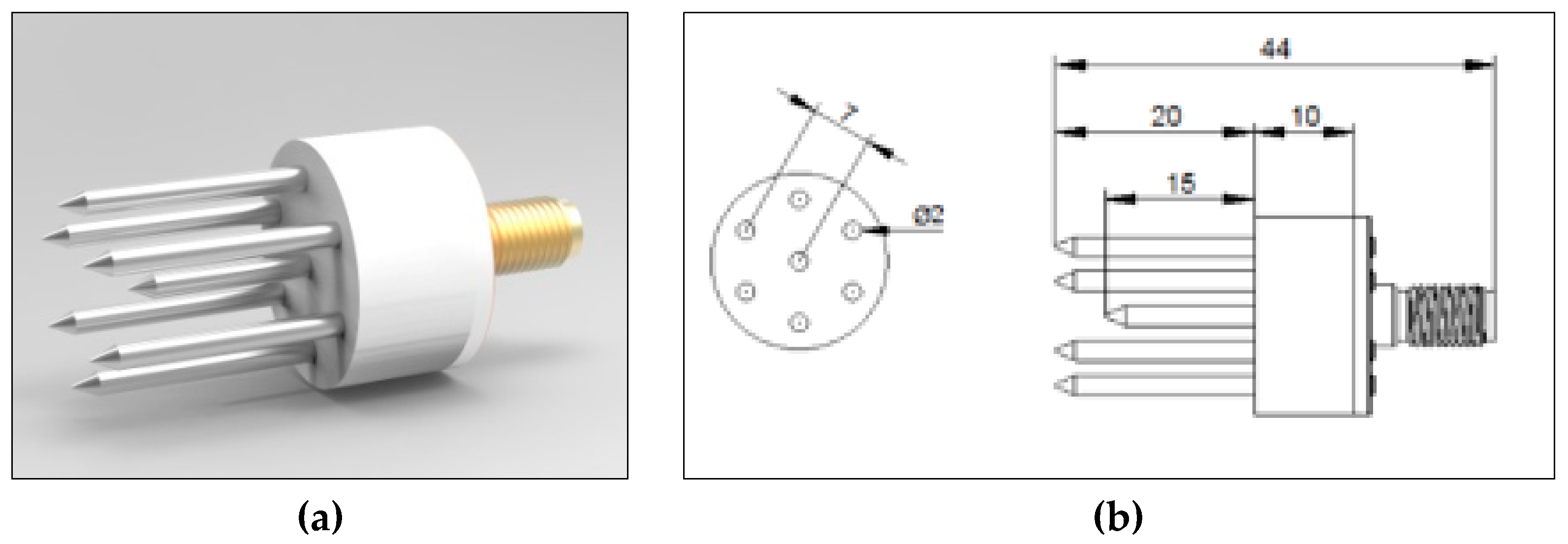
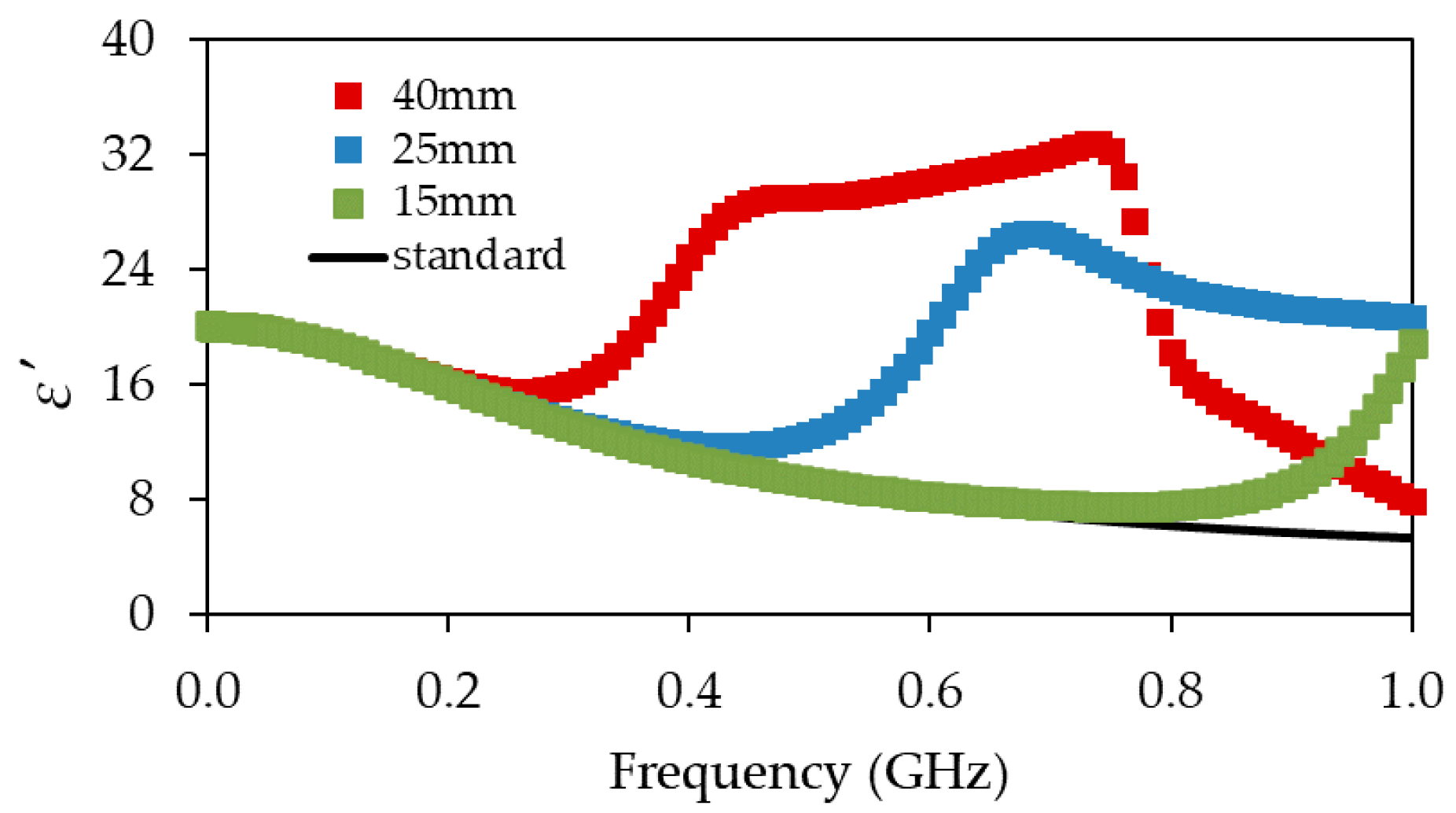
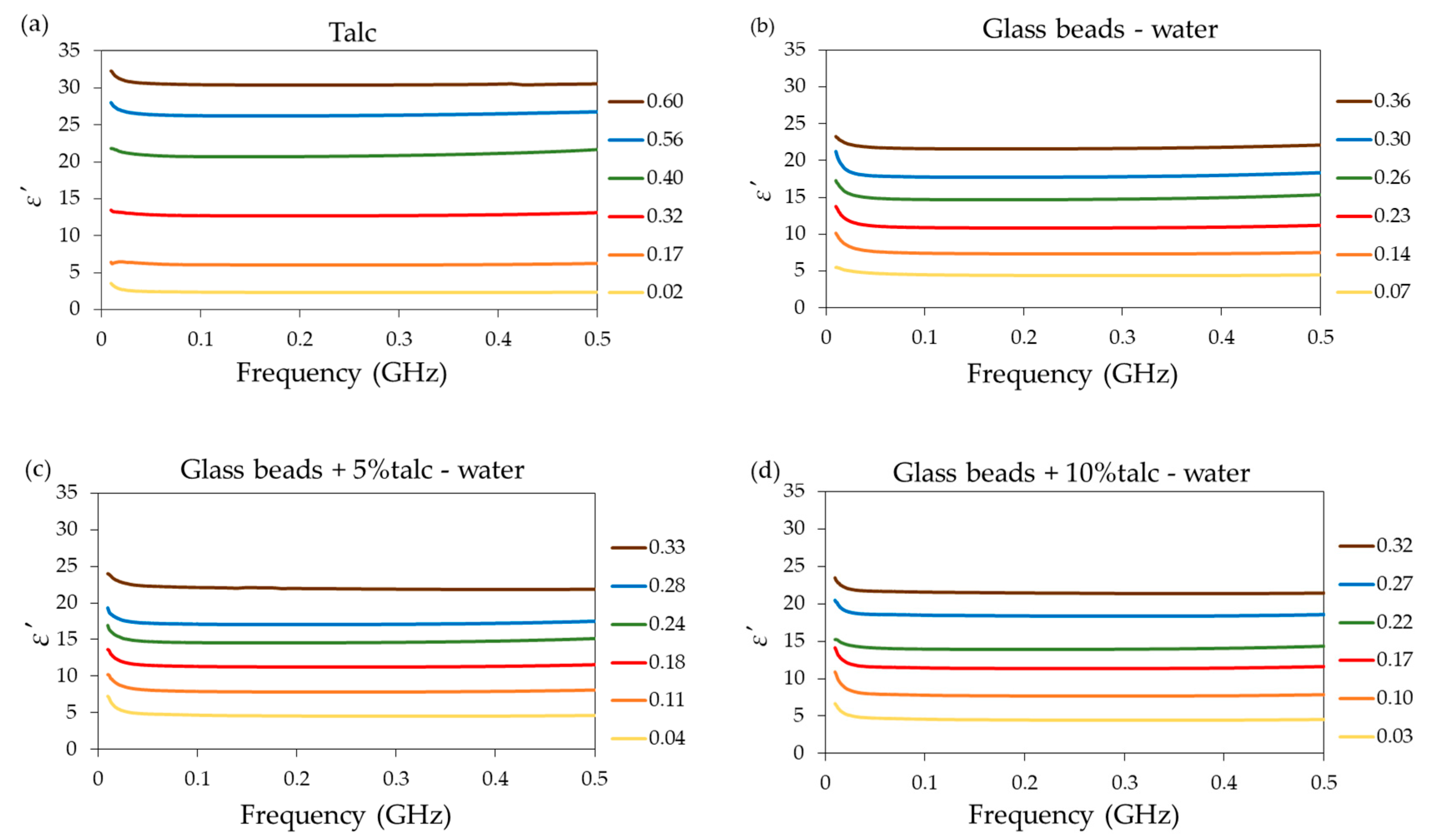

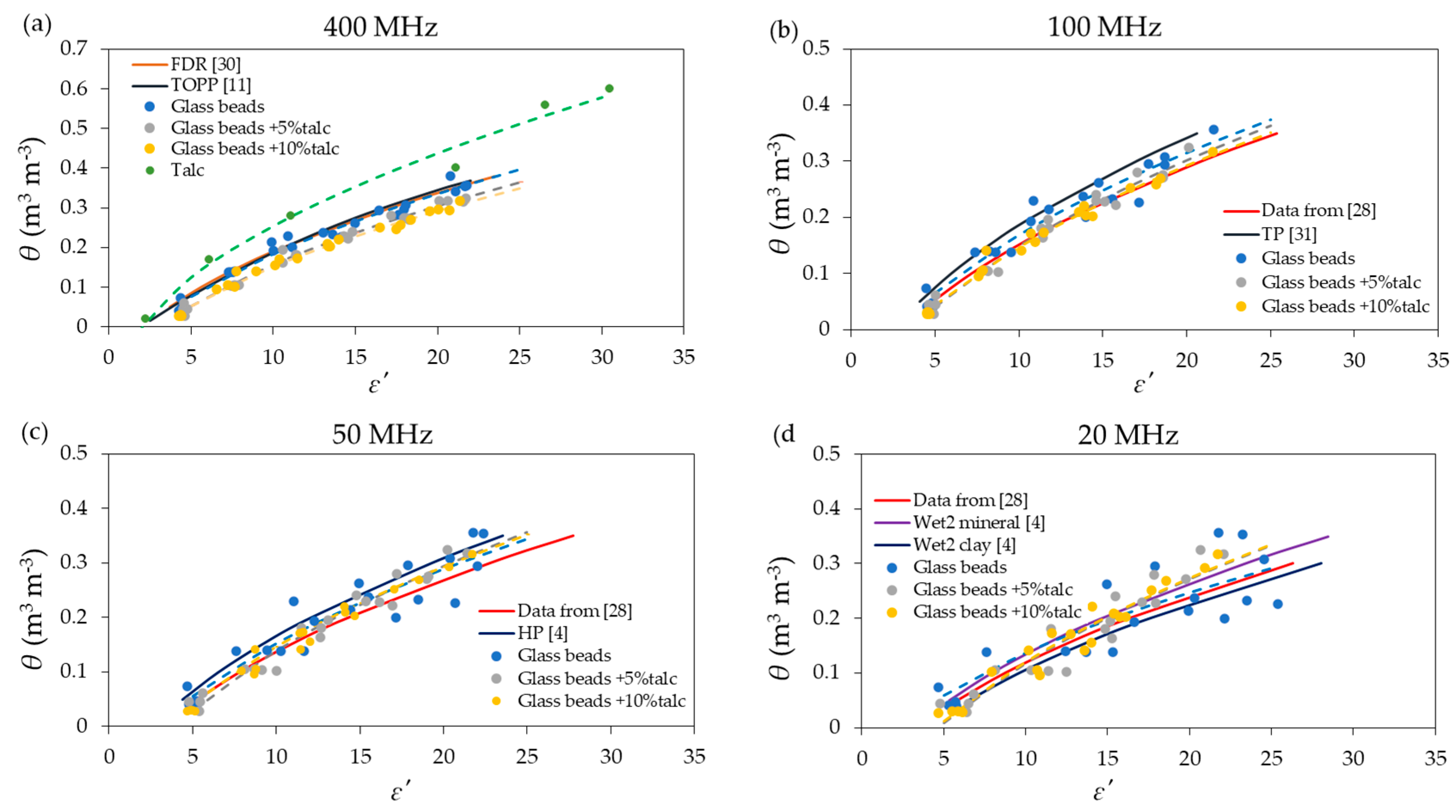
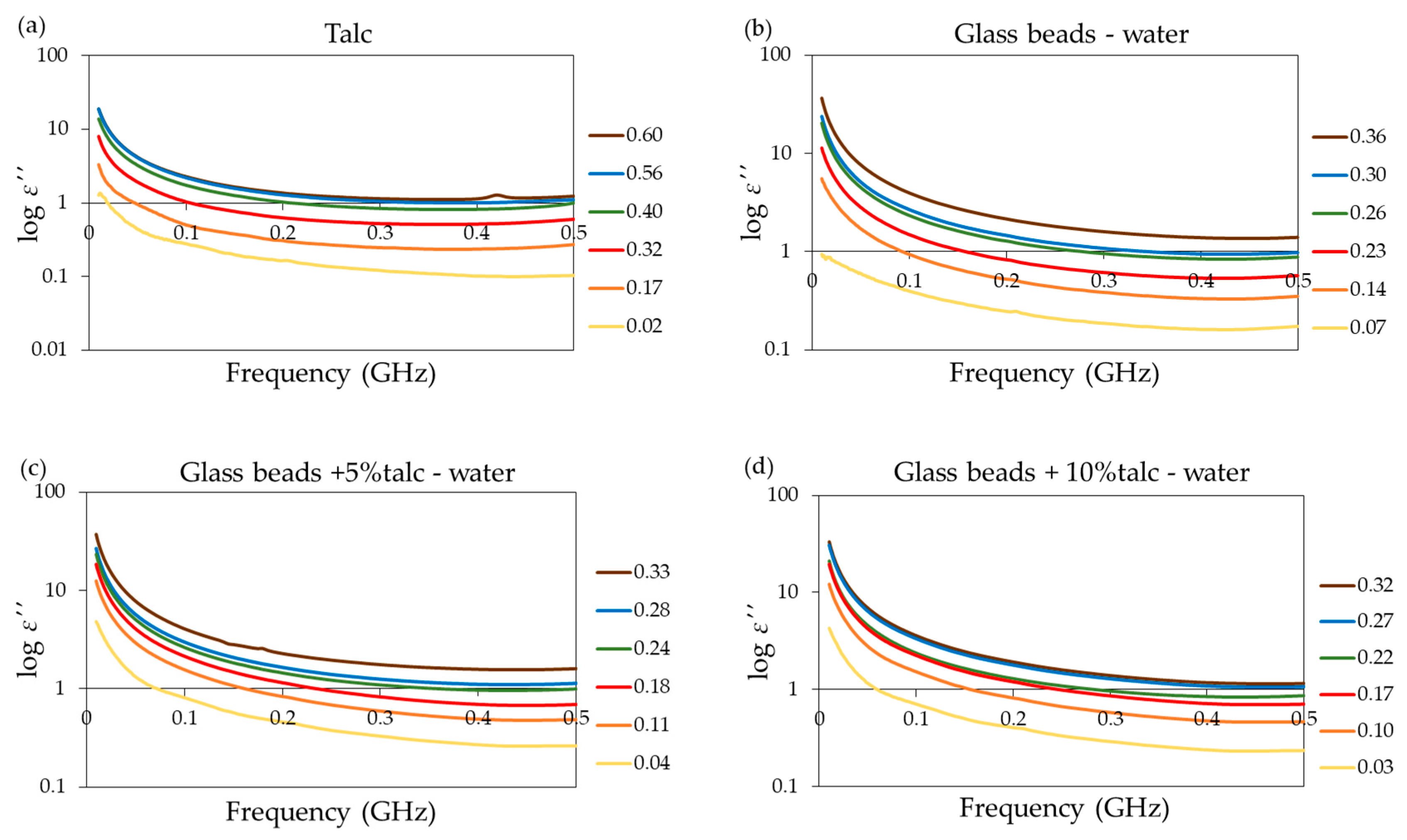

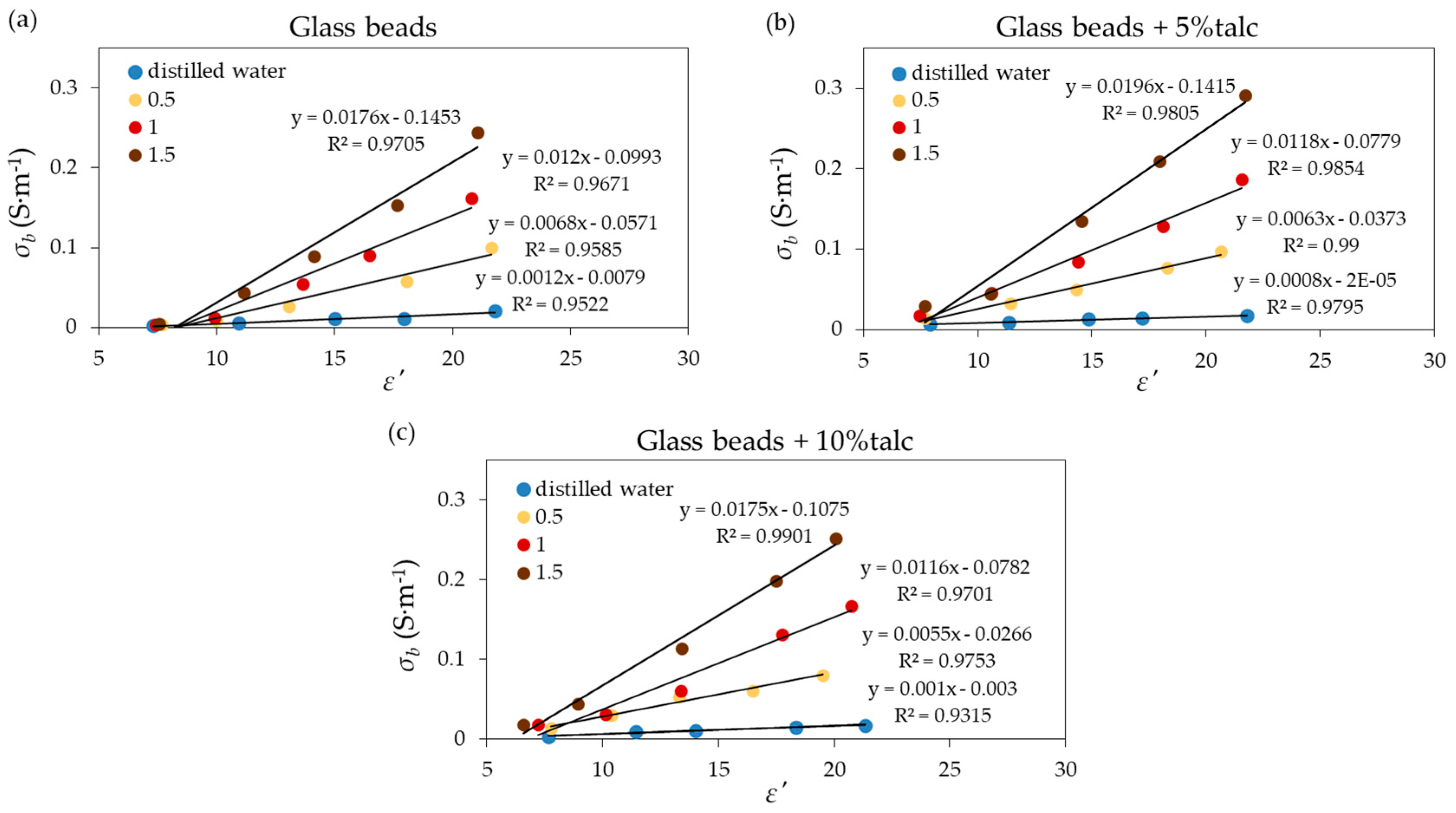
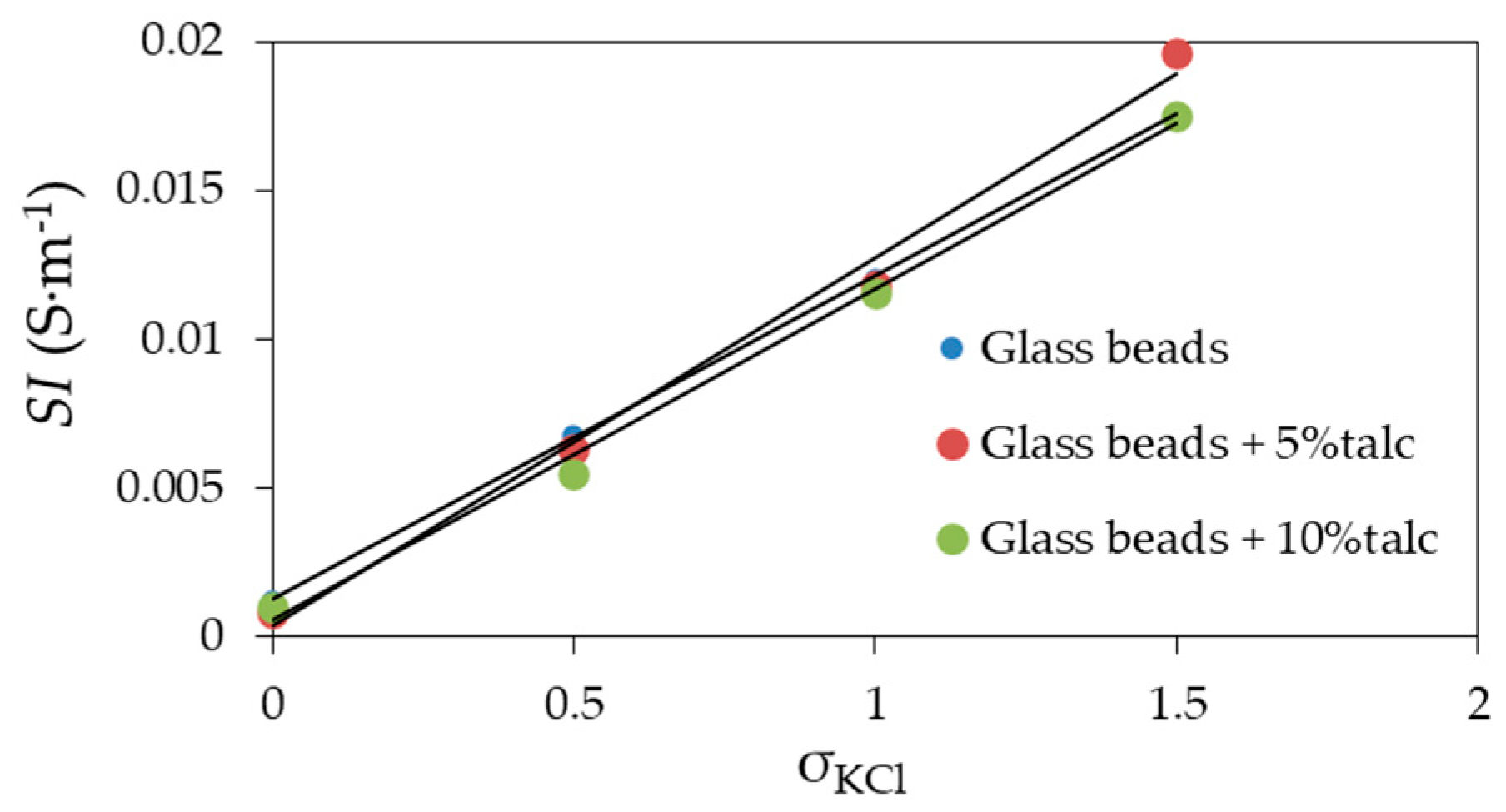
| Material | f (GHz) | A | B | R2 | RMSE |
|---|---|---|---|---|---|
| Talc-water | 0.02 | 0.1442 | 0.2196 | 0.9825 | 0.2311 |
| 0.05 | 0.1431 | 0.2068 | 0.9824 | 0.2339 | |
| 0.10 | 0.1426 | 0.2021 | 0.9823 | 0.2351 | |
| 0.40 | 0.1405 | 0.1902 | 0.9838 | 0.2288 | |
| Glass beads | 0.02 | 0.0841 | 0.1292 | 0.7030 | 0.6504 |
| 0.05 | 0.1038 | 0.1759 | 0.8752 | 0.3413 | |
| 0.10 | 0.1121 | 0.1862 | 0.9390 | 0.2113 | |
| 0.40 | 0.1163 | 0.1843 | 0.9757 | 0.2172 | |
| Glass beads and 5% talc | 0.02 | 0.1176 | 0.2540 | 0.8986 | 0.2585 |
| 0.05 | 0.1185 | 0.2368 | 0.9636 | 0.1543 | |
| 0.10 | 0.1168 | 0.2201 | 0.9776 | 0.1184 | |
| 0.40 | 0.1129 | 0.2002 | 0.9886 | 0.1166 | |
| Glass beads and 10% talc | 0.02 | 0.1169 | 0.2498 | 0.9375 | 0.1967 |
| 0.05 | 0.1147 | 0.2264 | 0.9806 | 0.1117 | |
| 0.10 | 0.1114 | 0.2062 | 0.9869 | 0.0919 | |
| 0.40 | 0.1076 | 0.1878 | 0.9900 | 0.0883 |
| Material | l | Std. Error | R2 |
|---|---|---|---|
| Glass beads | 0.0109 | 1.48·10−4 | 0.9998 |
| Glass beads and 5%talc | 0.0124 | 1.93·10−4 | 0.9918 |
| Glass beads and 10%talc | 0.0111 | 1.55·10−4 | 0.9958 |
© 2020 by the authors. Licensee MDPI, Basel, Switzerland. This article is an open access article distributed under the terms and conditions of the Creative Commons Attribution (CC BY) license (http://creativecommons.org/licenses/by/4.0/).
Share and Cite
Szerement, J.; Saito, H.; Furuhata, K.; Yagihara, S.; Szypłowska, A.; Lewandowski, A.; Kafarski, M.; Wilczek, A.; Majcher, J.; Woszczyk, A.; et al. Dielectric Properties of Glass Beads with Talc as a Reference Material for Calibration and Verification of Dielectric Methods and Devices for Measuring Soil Moisture. Materials 2020, 13, 1968. https://doi.org/10.3390/ma13081968
Szerement J, Saito H, Furuhata K, Yagihara S, Szypłowska A, Lewandowski A, Kafarski M, Wilczek A, Majcher J, Woszczyk A, et al. Dielectric Properties of Glass Beads with Talc as a Reference Material for Calibration and Verification of Dielectric Methods and Devices for Measuring Soil Moisture. Materials. 2020; 13(8):1968. https://doi.org/10.3390/ma13081968
Chicago/Turabian StyleSzerement, Justyna, Hironobu Saito, Kahori Furuhata, Shin Yagihara, Agnieszka Szypłowska, Arkadiusz Lewandowski, Marcin Kafarski, Andrzej Wilczek, Jacek Majcher, Aleksandra Woszczyk, and et al. 2020. "Dielectric Properties of Glass Beads with Talc as a Reference Material for Calibration and Verification of Dielectric Methods and Devices for Measuring Soil Moisture" Materials 13, no. 8: 1968. https://doi.org/10.3390/ma13081968
APA StyleSzerement, J., Saito, H., Furuhata, K., Yagihara, S., Szypłowska, A., Lewandowski, A., Kafarski, M., Wilczek, A., Majcher, J., Woszczyk, A., & Skierucha, W. (2020). Dielectric Properties of Glass Beads with Talc as a Reference Material for Calibration and Verification of Dielectric Methods and Devices for Measuring Soil Moisture. Materials, 13(8), 1968. https://doi.org/10.3390/ma13081968





